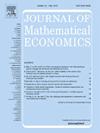时间之谜
IF 0.7
4区 经济学
Q3 ECONOMICS
引用次数: 0
摘要
退休收入基金将特殊的和系统性的长寿风险集中在参与者身上。本文研究了年金现金流分布优于传统年金现金流分布的条件。基于Leshno和Levy(2002)的几乎一阶随机优势(AFSD)准则,我们表明,只要后者包含精算负荷和/或退休人员低估了年金定价中假设的生存概率,适当设计的年金就会主导同等定价的固定年金。在大型池中,AFSD关系收敛于经典的一阶优势。因此,对于任何不断增加和持续消费的偏好,包括但不限于广义预期效用(GEU)和累积前景理论(CPT)框架,一旦池达到适度规模,退休人员就会选择tontine。我们量化了在规范性(GEU)和描述性(CPT)基准下占主导地位所需的最小参与者数量,并发现一个或两个数字通常是足够的。这些发现构成了我们所称的黄金之谜:尽管理论上它们对退休人员很有吸引力,但现实世界的黄金市场仍处于萌芽阶段本文章由计算机程序翻译,如有差异,请以英文原文为准。
The tontine puzzle
Retirement income tontines pool idiosyncratic and systematic longevity risk among their participants. This paper studies conditions under which the cash flow distribution of a tontine dominates that of a traditional life annuity. Building on the almost first order stochastic dominance (AFSD) criterion of Leshno and Levy (2002), we show that properly designed tontines dominate equally priced constant annuities whenever the latter embed actuarial loadings and/or the retiree underestimates the survival probabilities assumed in annuity pricing. In large pools the AFSD relation converges to classical first order dominance. Hence for any preference that is increasing and continuous in consumption, including but not limited to generalized expected utility (GEU) and cumulative prospect theory (CPT) frameworks, retirees prefer a tontine once the pool reaches a modest size. We quantify the minimum number of participants required for dominance under both normative (GEU) and descriptive (CPT) benchmarks and find that one or two digits are typically sufficient. These findings constitute what we label the tontine puzzle: despite their theoretical appeal to retirees, real world tontine markets remain nascent.1
求助全文
通过发布文献求助,成功后即可免费获取论文全文。
去求助
来源期刊

Journal of Mathematical Economics
管理科学-数学跨学科应用
CiteScore
1.70
自引率
7.70%
发文量
73
审稿时长
12.5 weeks
期刊介绍:
The primary objective of the Journal is to provide a forum for work in economic theory which expresses economic ideas using formal mathematical reasoning. For work to add to this primary objective, it is not sufficient that the mathematical reasoning be new and correct. The work must have real economic content. The economic ideas must be interesting and important. These ideas may pertain to any field of economics or any school of economic thought.
 求助内容:
求助内容: 应助结果提醒方式:
应助结果提醒方式:


